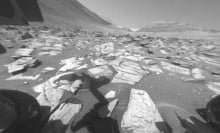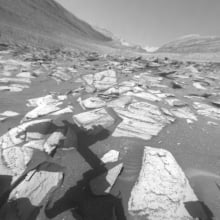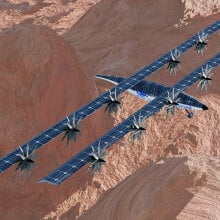This breathtaking downhill view of Martian canyons isn't just a glamor shot of the Red Planet in springtime but a crucial lookout for dusty gusts.
NASA's six-wheeled Curiosity rover took a drive along the Gediz Vallis Ridge in Mars' southern hemisphere this week. But the rover, which has been exploring the three-mile-high Mount Sharp since 2014, has to be vigilant for possible dust devils that could crop up around it.
In a mission update, Sharon Wilson Purdy, a planetary geologist at Smithsonian National Air and Space Museum, described the location on Mars as a "mouth-watering vantage point" to document a section of the ridge dubbed Fascination Turret.
"We hope to evaluate the processes that deposited the sediment in this ridge to understand how it formed and how it was later eroded to its present-day form," she wrote for the U.S. space agency.
Tweet may have been deleted
As it creeps through the desolate alien wilderness, Curiosity is exploring a key environment that could have been hospitable to tiny microorganisms once upon a time, if any ever inhabited Mars. The mountain is believed to have been ribboned with streams billions of years ago.
Gediz Vallis is a region of interest to planetary scientists searching for evidence that Mars was once wet, warm, and more Earth-like. They say ancient, fast-moving landslides swept mud and gigantic boulders down the mountainside. Over the ages, brutal Martian winds seem to have battered and worn away the debris, forming the ridge.
"I can't imagine what it would have been like to witness these events," William Dietrich, a geologist on the Curiosity mission team, said in a previous statement. "Huge rocks were ripped out of the mountain high above, rushed downhill, and spread out into a fan below."

Scientists have long known the hazards of dust devils churning up Martian dirt. About 12 years ago, the Mars Reconnaissance Orbiter caught sight of an extraordinary one with a plume stretching 12 miles into the sky.
Dust devils on Mars form similarly to those on Earth, despite the fact that Mars' atmosphere is much thinner. They tend to happen on dry days when the ground gets hotter than the surrounding area, according to NASA. Typically smaller than tornadoes, dust devils are whirlwinds that make a funnel-like chimney, channeling hot air up and around.
The rotating wind accelerates similar to the way spinning ice skaters move faster as they bring their arms closer to their bodies.

But on Mars, this wind phenomenon leaves tracks — straight lines, curves, and curlicues — where it has traveled. The color is a result of picking up the light dust coating virtually all of the Red Planet, exposing layers of dark volcanic rocks.
Right now, Curiosity's team is bracing for potential global dust storms. All previous ones of this scale observed by NASA scientists have happened between now and September. The team is busy measuring atmospheric dust levels.
"Although these huge atmospheric events are generally separated by many years," said astronomer Deborah Padgett in a mission post, "the last sky-darkening global Martian dust storm in 2018 ended the mission of our beloved Opportunity Rover."
Topics NASA































